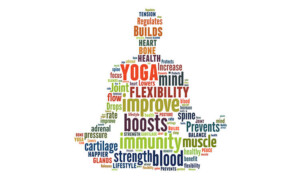Sage Patanjali defines it as “Yogaschitta vritti nirodhah” or to control the faculties of mind/Chitta”. The basic concept of yoga as per Sage Patanjali consists of 8 steps/parts/stages. Through aasanaas, body would become pain free and physically more fit. Practice of pranayama or conscious breathing, would lead to a state of mental relaxation and better oxygenation of all body tissues and help prevent and improve or cure many illnesses. Deeper meditation through the stages of pratyaahar, dhaarna, dhyaan and samaadhi would further free the mind from external stress/influences leading to internalization and then focusing of mind on the inner self or atma/parmatma. So yoga is basically a holistic approach to living as a whole. Practice of Yoga is to be tailored based on an individual person’s needs. Positive thinking results in better sense of mind. Yoga is self-empowering, resulting in better sense of wellbeing.
Origin of disease/illness
In USA, about 4% or more people practice yoga. In order to understand the benefits of Yoga, it is important to understand why illnesses occur. We have 10 trillion cells and 100 trillion bacteria living in our gastrointestinal system, mainly in colon. Research on various organ systems has proven that various levels of pains in body, hypertension, heart disease, various digestive, nervous system and mental disorders have their origin in coping with various levels of stresses in life. Simply put, practice of Yoga teaches a person confidence, gives ability to cope with life situations better, provides strength and relaxation and reduces illnesses at various levels.
Nervous System- Humans have about 100 billion neurons and 30-100 different chemicals or neurotransmitters in brain. Each neuron communicates with the next one through what is called a synapse, a gap where chemicals are liberated from the axon of one neuron to communicate with the dendrite of the next neuron by liberation of a chemical/neurotransmitter. Lot of what happens at a given moment depends on the net result of how many neurons are involved, what chemical is liberated, which parts of brain are involved in action and so forth. Some memories of experiences are left in parts of brain called the Amygdala and Hippocampus and other higher centers, which govern the reaction or the response of the person to the subsequent events in life. Though Yoga, modifications can be made in this response to tone down the hypothalamic-pituitary-adrenal system by shifting from sympathetic to parasympathetic activity leading to decrease in salivary cortisol, blood glucose, plasma renin, 24 Hr. Urinary
norepinephrine/Epinephrine levels and Heart Rate, Systolic and Diastolic BP. Here is the proposed list of benefits which yoga can achieve:
Increased sense of wellbeing, better muscular and overall physical strength, increased discipline, increased self-esteem and resultant success in life.
There is logical reason to believe that practice of yoga can be of help in great deal of illnesses, especially those which are known to get better when one attains peace of mind. To account a few, Yoga can be beneficial in sleep disorders, anxiety and depression, reduction of suicides, homicides and other crimes, substance abuse/dependence, Neurovascular and other nervous system disorders, arthritic conditions and chronic pain, through better posture, increased mobility and reduced wear and tear, . Cardiovascular conditions such as heart attack, improved digestive Function, allergic disorders, genito-urinary disorders such as altered menstrual cycle and dysmenorrhea, endocrine disorders such as thyroid dysfunction, diabetes and obesity and metabolic syndrome and even prevention and possibly retardation of growth of some malignancies.
So many studies have been done in various universities in India, United States and other countries showing some of these benefits. For example, bhasrika pranayama with rate of 6/minute with 4 second inhalation and 6 second exhalation done for 5 minutes decreased both systolic and diastolic BP. Dissolved oxygen has been shown to be increased by pranayama. Respiratory function tests show better parameters following yoga sessions. Strength of both inspiratory and expiratory muscles is increased.
Yoga and its effect on chemicals in brain:
GABA is a chemical positively associated with relaxation and reduction of brain activity. In experienced yoga practitioners, brain GABA levels were measured by doing magnetic resonance spectroscopy. Levels were found to be 27% higher after a session of yoga. This suggests that the practice of yoga should be explored as a treatment for disorders with low GABA levels such as depression (50% lower GABA levels in occipital cortex) and anxiety disorders. Future studies should compare yoga to other forms of exercise to help determine whether yoga or exercise alone can alter GABA levels.
“Division of Psychiatry, Boston University School of Medicine, Boston, MA 02118, USA”.
Yoga-neuro-modulation:
Yoga inhibits posterior or sympathetic area of the hypothalamus, resulting in optimization of body’s sympathetic response to stressful stimuli and restores stress regulation in body. Yoga inhibits the areas of brain responsible for fear, aggressiveness and rage and stimulates the rewarding pleasure centers in the median forebrain and other areas leading to state of bliss and pleasure. Consistent yoga improves depression and increases serotonin levels and decreases MAO levels. Yoga therapy increases positive coping skills and builds self-esteem without harmful side effects.
Depression, stress and anxiety disorders arise from a dysfunction in the modulation of brain circuits which regulate emotional responses to potentially threatening stimuli which involve bottom-up activity from the amygdala, indicating the presence of potentially threatening stimuli, and top-down control mechanisms originating in the prefrontal cortex, signaling the emotional salience of stimuli. Level of neuronal inhibition is down regulated in pathological anxiety states. Targeting the neuro-steroid-GABAA receptor axis represents an attractive target for the modulation of anxiety.
Yoga and Immune system
There is an intricate network of bi-directional relationships between the immune system and the brain. Depression has been found to alter the immune system. Immune system can influence the brain and behavior. Consequences of these effects on the brain include depression, anxiety, fatigue, psychomotor slowing, anorexia, cognitive dysfunction and sleep impairment.
Natural therapies such as Yoga have been found to have positive influence on the immune system, psychomotor illnesses and organic illnesses as well.
BrainBrain areas of relevance for Yoga and meditation are:
Frontal lobe, Parietal lobe, Limbic System and Reticular System.
Frontal Lobe is also called Attention Association Area (AAA). It deals with will-power, focus of attention/energy and concentration. Prefrontal area is the brain’s top executive. It organizes responses to complex problems, guides behavior with verbal skills and houses networking memory. It is also connected to the limbic system and helps to mediate attention, emotion, and memory
Parietal Lobe is called the Orientation Association Area (OAA). Receives and processes sensory information from the body. Deals with orientation in space and speed of objects. Distinction between self and world. It is also the seat of seat of mind and ego
ingulate Gyrus- emotion formation and processing, learning, and memory,
Parahippocampal Gyrus- memory encoding and retrieval,
Hippocampus- long term memory of facts and events.
Amygdala- emotional memory and reaction to fear. It is larger in males
Thalamus- two way relay station
Hypothalamus-maintains body’s body functions, such as BP, Weight, temperature and appetite
Mammillary Body- relay signals to thalamus contributing to alertness and memory formation
Reticular System, through our senses, information of various types is being fed constantly to our brain through our nerves. This information travels back and forth to our brains through the brain stem in a series of long nerve pathways called the reticular system. This plays an important role in regulating our autonomic nervous system. Reticular system constitutes an arousal mechanism that keeps the brain alert and keeps us awake. Information from the reticular system goes to part of brain called thalamus and then on the brain.
Meditation and Frontal Lobe Activity
Brain size in meditators: Meditators showed significantly larger volumes of the regions which regulate emotions. These are: hippocampus, prefrontal cortex, thalamus, inferior temporal gyrus, and Rt. Insula. There was also a slowdown of decrease in putamen size with age.
Brain Waves during mediation
There are 4 types of waves in brain.
Beta Waves: occur when the brain is working on a goal oriented task. These are minimal during meditation.
Alpha Waves: A person who takes a break from a conference and walks in the garden is often in an alpha state. These also occur and in the posterior parts of the brain during meditation.
Theta Waves: EEG recordings during deep meditation showed extremely powerful Theta waves in the left prefrontal cortex. Also occur during dreaming.
Delta waves: These are present during sleep and at times during dreams. This indicates that sleep is distinct from meditation.
Good Habits: Doing Pranayama, Waking up early, Going to sleep early, Eating light, right, and the last meal at least three hours before going to sleep, Sleeping on the left side, Drinking a lot of waterAvoiding processed foods and artificial drinks, chocolates, caffeine, soda, etc.



